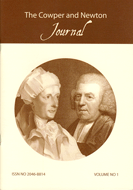Congratulations to Simon Watson on a useful new guide to William Cowper’s life and work. There is such a dearth of material about Cowper and his contemporaries that any introduction is welcome, but An April-Weather Life manages to be an enjoyably-written and vivid account that will encourage readers to make their own excursions into the writing of the period.
How fashions in reading have changed in the last 180 years. It is said that between 1782, when the first edition of Cowper’s poems appeared, and 1837, the year in which the Poet Laureate Robert Southey completed his own monumental Life and Works of Cowper, more than a hundred editions of Cowper’s poems were published in Britain and almost fifty in America. In 1833, Thomas Taylor, one of Cowper’s early biographers, began his book on Cowper with an apology for adding to the large number of biographies already available. Taylor’s work was to be ‘full, fair and unbiased’. Like Thomas Taylor, Simon Watson has set out to produce a fair and unbiased account, and within his 72 pages he covers a lot of ground.
An April-Weather Life is largely dependent on secondary sources, but there are sufficient quotations to give the reader a sense of Cowper’s work and the milieu in which he lived. The outline of the book is chronological, from Cowper’s birth in Berkhamsted in 1731 to his death in East Dereham in 1800. At appropriate points Simon Watson expands on current critical thinking; he describes Cowper’s place in the evangelical tradition, his relationship with John Newton, recent thinking on Cowper’s mental state and sexuality, and the contemporary eighteenth-century sense of decorum and moralising which formed the background to his poetry. The book nicely complements the 2001 work by Dr K. E. Smith, William Cowper: A Reappraisal, also available from The Cowper and Newton Museum. Like the earlier work it is similarly accessible to the general reader, with less information on the poetry and translations but with the advantage of illustrations and a remarkably modest price of just £4.99.
As a general reader myself, I would have liked to have seen rather more of William Cowper the letter writer and man of the world, but there is a limit to how much can be covered in a short introduction. Simon Watson recognises the contradictions in Cowper and his interest in the wider world beyond his life of retirement in and around Olney. But in the main his Cowper is a melancholic figure, ‘obsessed by his own damnation’, whose great achievement was to become ‘the poet of the ordinary man’. Watson’s final summary reads ‘His life was a tragedy: his work was a triumph’. But of course Cowper was also the ironist who delighted in recounting the incidents and curiosities of daily life, the celebrated gentleman scholar who sent to London for books and enjoyed the company of the well-read, and who built his reputation as a poet through hard work and regular negotiations with his publisher.
To eighteenth-century contemporaries Cowper was something of a celebrity. In the same letter from which the title of the book is taken, he recounts how it feels to be seen as a modern Orpheus. ‘It is a sort of April weather life we lead in this world’, he writes to his old school friend William Bagot in January 1787, ‘a little sunshine is generally a prelude to a storm’. The ‘storm’ recounted in the letter was the death of Mrs Unwin’s son William. But most of the letter relates not to that but to Cowper’s grapplings with his translation of a particularly bloodthirsty part of Book XIII of The Iliad. The Odyssey, he says, was the better book. It took an eighteenth-century mind to enjoy such distinctions. So thanks to Simon Watson for re-introducing readers to the special mind that was William Cowper’s. And hopefully too An April-Weather Life will encourage them to learn more about his work, with a visit to the Cowper and Newton Museum.

